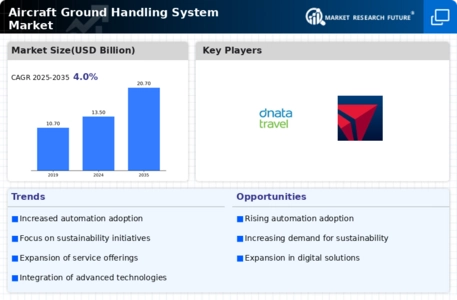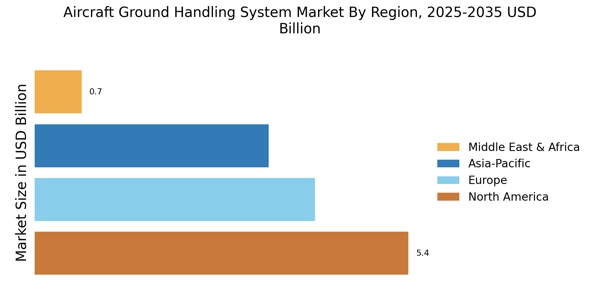The Aircraft Ground Handling System Market is characterized by a dynamic competitive landscape, driven by increasing air traffic and the need for efficient ground operations. Key players such as Swissport International Ltd (CH), Menzies Aviation (GB), and Dnata (AE) are at the forefront, each adopting distinct strategies to enhance their market positioning. Swissport International Ltd (CH) focuses on digital transformation, investing in advanced technologies to streamline operations and improve service delivery. Menzies Aviation (GB) emphasizes regional expansion, particularly in emerging markets, to capture new growth opportunities. Dnata (AE) is leveraging strategic partnerships to enhance its service offerings, thereby strengthening its competitive edge. Collectively, these strategies contribute to a moderately fragmented market structure, where innovation and operational efficiency are paramount.
In terms of business tactics, companies are increasingly localizing manufacturing and optimizing their supply chains to enhance responsiveness and reduce costs. The competitive structure of the market appears to be moderately fragmented, with several key players exerting influence over their respective regions. This fragmentation allows for a diverse range of services and innovations, although it also intensifies competition among the major players.
In August 2025, Swissport International Ltd (CH) announced a partnership with a leading technology firm to implement AI-driven solutions for baggage handling. This strategic move is expected to significantly reduce turnaround times and enhance operational efficiency, positioning Swissport as a leader in technological innovation within the ground handling sector. The integration of AI not only streamlines processes but also improves customer satisfaction, which is increasingly becoming a critical differentiator in the market.
In September 2025, Menzies Aviation (GB) expanded its operations in Asia by acquiring a local ground handling company. This acquisition is strategically important as it allows Menzies to tap into the rapidly growing aviation market in the region, thereby enhancing its service capabilities and market share. The move reflects a broader trend of consolidation within the industry, where companies seek to bolster their presence in high-growth areas.
In July 2025, Dnata (AE) launched a sustainability initiative aimed at reducing carbon emissions across its ground handling operations. This initiative underscores Dnata's commitment to environmental responsibility and aligns with the increasing demand for sustainable practices in the aviation sector. By prioritizing sustainability, Dnata not only enhances its brand reputation but also positions itself favorably in a market that is progressively leaning towards eco-friendly solutions.
As of October 2025, the competitive trends in the Aircraft Ground Handling System Market are increasingly defined by digitalization, sustainability, and the integration of AI technologies. Strategic alliances are becoming more prevalent, enabling companies to leverage complementary strengths and enhance service offerings. Looking ahead, it is anticipated that competitive differentiation will evolve, shifting from traditional price-based competition to a focus on innovation, technological advancements, and supply chain reliability. This evolution suggests that companies that prioritize these aspects will likely emerge as leaders in the market.


















Leave a Comment